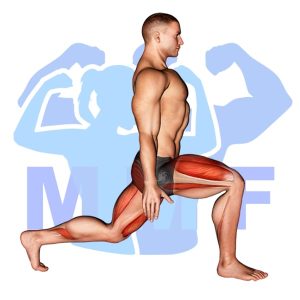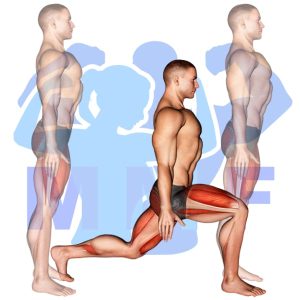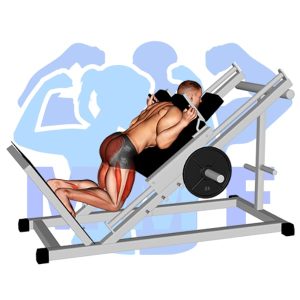Do you struggle with strengthening your lower body? Are you tired of doing the same leg exercises over and over? Perhaps you haven’t tried the dumbbell rear lunge. Many people underestimate the benefits of this exercise, but the truth is that it is an effective way to tone your glutes, hamstrings, and quads. It’s understandable that trying new exercises can be intimidating, but we’ve got you covered. In this post, we will guide you through the proper form and technique for the dumbbell rear lunge, so you can add it to your fitness routine with confidence and see results. Say goodbye to boring leg day and take your workout to the next level with this powerful exercise.
Dumbbell Rear Lunge Summary
- Primary Muscles: Gluteus Maximus
- Secondary Muscles: Adductor Magnus, Quadriceps, and Soleus
- Equipment: Dumbbells
- Mechanics Type: Compound
- Force: Push
- Utility: Basic or Auxiliary

Dumbbell Rear Lunge Instructions
- You may get started by taking a pair of dumbbells, one in each hand.
- Begin the lunge by standing up straight and stepping back about one and a half times your normal step length.
- Lunge down by bending both knees, allow your back knee to come close to, but not touching the floor.
- Then, press back up pushing off with your back foot to come back to a standing position.
- Continue to do it again with the same leg or alternate legs each rep. Continue until you have done a entire set on both legs.
Video Tutorial
Dumbbell Rear Lunge Muscles
Target (Agonist)
Synergists
- Adductor Magnus
- Quadriceps
- Soleus
Dynamic Stabilizers
Stabilizers
- Erector Spinae
- Gluteus Medius
- Gluteus Minimus
- Levator Scapulae
- Obliques
- Quadratus Lumborum
- Tibialis Anterior
- Trapezius – Middle
- Trapezius – Upper
Antagonist Stabilizers
- None

Benefits of Dumbbell Rear Lunge
The Dumbbell Rear Lunge is a great exercise for targeting the Gluteus Maximus, one of the most powerful muscles in the body. This exercise can help build strength in the lower body while also improving balance, coordination, and stability. Additionally, performing this exercise regularly can help to reduce the risk of injury and improve overall athleticism. The Dumbbell Rear Lunge can also help to increase power output, and it can be used as a great way to add variety to any strength training or fitness routine.
Tips for Performing Dumbbell Rear Lunge
If you’d like to generate the best outcomes, you need to take advantage of these easily done tips. Furthermore, whenever you wish to protect yourself against an injury, you ought understand these tips.
- Improve Your Technique by Make Use Of A Mirror. You may well believe a little vain looking in a mirror whenever you are training, but you are not admiring yourself, you are insuring your technique is effective.
- Slow Each Repetition Down For Greater Strength Gains. By Raising the time under tension you are engaging your muscles longer and they will respond by gaining toned muscles. You can do this without raising the resistance by slowing down you reps about 4 – 6 seconds flexing and pause then 4 – 6 seconds expanding.
- Work out By A Place Where You Are Able To Look At Your Technique In A Mirror. You need to find a way to maintain solid technique on every single repetition, so you can accomplish this you ought to have the ability observe and fix your technique.
- Execute At Least 3 Of 8-20 Repetitions For Muscle Bulk. Presently there are several theories regarding how Increased Muscle Size is initiated, most agree that sets of 60-80% of your 1RM will lead to increased muscle size.
Benefits and Tips Video
Frequent Mistakes To Avoid
You ought to stop these fairly typical issues to keep quality technique and continue to develop gains. Likewise, when you stay away from these issues you will minimize the opportunity of getting injuries.
- You Don’t Want To Omit Your Warm-Up. getting the blood flowing to your Muscle tissue is the Fastest way to avoid injury.
- You’ll Do Better To Not Neglect Any Of Your Pains. Sore muscle tissue and pain from injuries are definitely not the same. Any time you come to feel serious pain after you are working out you should stop, or you will simply just mhelp make this injury worse yet.
- You’ll Do Better To Not Attempt To Lift To Much Weight. You may forfeit your form and could end in an injury whenever you attempt to lift more than you should.
Find More Dumbbell Exercises Here
Variations and Complementary Exercises
To add variety to your workout and target the same muscles as the Dumbbell Rear Lunge, you can try these variations, complementary, or alternative exercises. These exercises will help you build strength and stability while targeting your glutes, quads, and hamstrings.
Dumbbell Walking Lunges

Dumbbell Walking Lunges are an excellent complementary or alternative exercise to Dumbbell Rear Lunges. This exercise focuses on the same muscle groups as the rear lunge while providing a slightly different challenge. To perform this exercise, start in a standing position with your feet slightly wider than shoulder width apart. Step forward with one leg and lower yourself into a lunge position, keeping your weight on your heel and your back straight. Push off with your front foot to stand up again and continue alternating legs as you take each step. This exercise helps to strengthen the quads, glutes, hamstrings, and calves while also improving balance and coordination.
Lunge

The lunge is a great complementary or alternative exercise to the dumbbell rear lunge. It involves stepping forward with one foot and then slowly lowering your body until the back knee is almost touching the ground. The lunge targets the quadriceps and glutes, while also working the core and other stabilizing muscles. It is a great lower body exercise that can help to improve balance and coordination. Additionally, it can help to increase flexibility in the hips, which is essential for proper form during all lower body exercises.
Rear Lunge

Rear Lunges are a great complementary or alternative exercise to Dumbbell Rear Lunges. The movement is similar, but instead of using dumbbells, the individual steps back with one leg and then lowers their body down. This targets the glutes, quads, and hamstrings and is great for improving balance and mobility in the lower body. The rear lunge can be performed with or without additional weight to increase difficulty, making it a great choice for both beginner and advanced exercisers.
Check Out These Top Dumbbell Exercises
Walking Lunge

Walking Lunge is a great complementary or alternative exercise for Dumbbell Rear Lunge. It works the same muscles, but with a different motion. When performing Walking Lunges, you step forward with one leg and lower your body until your front knee is bent at a 90 degree angle. This exercise targets the quads, glutes, hamstrings, and core. It also helps build strength and balance. Unlike Dumbbell Rear Lunge, Walking Lunge can be done without any additional equipment.
Barbell Forward Lunge

The Barbell Forward Lunge is a great complementary or alternative exercise to the Dumbbell Rear Lunge. This exercise works the same muscles as the Dumbbell Rear Lunge, but with a different angle of movement. To perform a Barbell Forward Lunge, stand with your feet shoulder width apart and hold a barbell across your upper back. Step forward with one foot, bending your knee and lowering your body until your back knee nearly touches the ground. Make sure to keep your chest up and back straight throughout the movement. Push off with the front foot to return to the starting position and repeat on the other side. This exercise is a great way to build strength and stability in the lower body.
Barbell Lateral Lunge

Barbell Lateral Lunge is an excellent complementary or alternative exercise for Dumbbell Rear Lunge. It is a unilateral lower body exercise that targets the glutes, quads, and hamstrings. It also helps improve balance and core stability. To perform the exercise, stand with your feet shoulder width apart and hold a barbell at your chest. Take a wide step out to the side while keeping your core tight and lowering your body into a lunge position. Push off your front foot and return to the starting position. This exercise is great for developing strength and stability in the lower body and can help improve overall performance when used as an alternative or complementary exercise to Dumbbell Rear Lunge.
Find More Glutes Exercises Here
Opposing Complementary Exercises
Complementary exercises can help to strengthen the opposing muscle groups used in Dumbbell Rear Lunge. To ensure that your body is working in balance and not overworking any particular muscle group, it is important to include exercises that work the opposite muscles. Below is a list of exercises that will help you strengthen the muscles in opposition to those used in Dumbbell Rear Lunge.
Sled Reverse Hack Squat

The Sled Reverse Hack Squat is a great complementary exercise to the Dumbbell Rear Lunge. It works the opposing muscle group of the glutes, hamstrings, and calves. This exercise is great for strengthening the backside of the lower body, as well as increasing stability and balance. The Sled Reverse Hack Squat helps to ensure that the entire posterior chain is worked, which is important for overall health and performance. By combining the Dumbbell Rear Lunge and Sled Reverse Hack Squat, you can achieve a balanced workout that will help you reach your fitness goals.
Sled One Leg Hack Squat

The Sled One Leg Hack Squat is a great exercise to pair with the Dumbbell Rear Lunge. By performing the Sled One Leg Hack Squat, you are targeting the quads and core muscles, which are opposing muscle groups to the glutes and hamstrings used in the Dumbbell Rear Lunge. This combination of exercises works together to build stability, balance, and strength throughout the lower body. Furthermore, the Sled One Leg Hack Squat is great for developing unilateral strength and can be used to address any strength imbalances between each leg.
Sled Narrow Stance Hack Squat

The Sled Narrow Stance Hack Squat is a great complement to the Dumbbell Rear Lunge exercise. This compound movement works the quadriceps, glutes, and hamstrings, while the Dumbbell Rear Lunge works the glutes, hamstrings, and calves. The Sled Narrow Stance Hack Squat works the quads and glutes in a more vertical plane of motion while the Dumbbell Rear Lunge works the glutes and hamstrings in a more horizontal plane of motion. By combining these two exercises, you will be able to activate both the quads and glutes in a more complete manner. Not only that, but you will also be able to work opposing muscle groups in both vertical and horizontal planes of motion, allowing you to achieve better overall muscle development.
Revamp Your Lower Body Workout with Dumbbell Rear Lunges
If you’re looking to switch up your lower body workout, adding dumbbell rear lunges can bring some new challenges to your routine. This exercise targets your glutes, hamstrings, and quads, while also improving your balance and coordination. By holding a dumbbell in each hand, you increase the resistance, making it a great option for those looking to increase their strength. Plus, it’s a relatively low-impact exercise, making it a good choice for those with knee or lower back pain. Give this exercise a try and see how it can add some variety to your lower body routine.
References: Wikipedia | ExRx.net | PubMed.gov | Comprehensive List of Glutes Dumbbell Exercises




